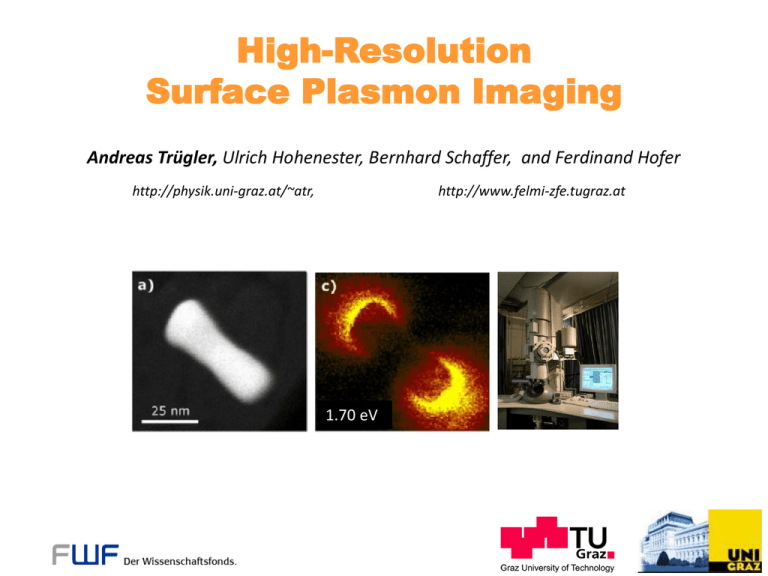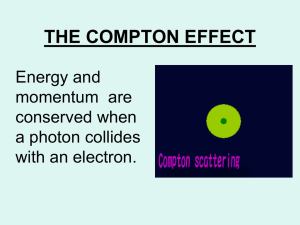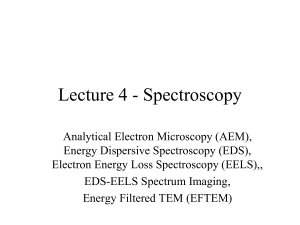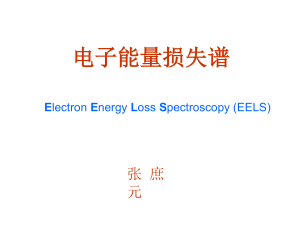PPT
advertisement

High-Resolution Surface Plasmon Imaging Andreas Trügler, Ulrich Hohenester, Bernhard Schaffer, and Ferdinand Hofer http://physik.uni-graz.at/~atr, http://www.felmi-zfe.tugraz.at 1.70 eV W. Barnes et al., Surface plasmon subwavelength optics, Nature 424, 824 (2003). H. Atwater, The promise of plasmonics, Scientific American 296(4), 56 (2007). „Flat light“ Particle plasmons Meta materials Agenda: Theoretical background and how to map a plasmon Simulation technique Comparison between experiment and theory The promise of plasmonics... Theoretical background and how to map a plasmon No! Because the wavelength of light is (much) larger than the nanoparticle but: What about other microscopy techniques? EELS Electron Energy Loss Spectroscopy EFTEM Energy Filtered Transmission Electron Microscopy F. J. García de Abajo : Optical excitations in electron microscopy, arXiv:0903.1669v1 (2009) Can one „directly see“ surface plasmons? Electron beam excites surface plasmon (evanescent source of radiation) Surface plasmon acts back on electron Raster scanning of electron beam probes dielectric environment of MNP ~ 100 keV electrons ( approx. 70 % of c ) Electron interaction Maxwell‘s equations: 4-vector notation, . Solution by Green’s functions: Structure of equations we want to solve: Green function equation: Liénard-Wiechert potentials Maxwell‘s equations: 4-vector notation, . Solution by Green’s functions: Structure of equations we want to solve: Solution for an arbitrary charge distribution: Liénard-Wiechert potentials Solution for a relativistic moving charge: Charge distribution of an electron moving along r(t): Liénard-Wiechert potentials Solution for a relativistic moving charge: Charge distribution of an electron moving along r(t): Liénard-Wiechert potentials Solution for a relativistic moving charge: Charge distribution of an electron moving along r(t): Liénard-Wiechert potentials Solution for a relativistic moving charge: Charge distribution of an electron moving along r(t): Liénard-Wiechert potentials Solution for a relativistic moving charge: Charge distribution of an electron moving along r(t): Final potentials: Liénard-Wiechert potentials Energy loss of the fast electron: Fourier transform Energy loss can be related to the work against the induced electric field! Process reminiscent of a self energy. Probe of the electrost. potential of the SP! U. Hohenester, H. Ditlbacher, and J. R. Krenn: On the interpretation of electron energy loss spectra of plasmonic NPs (to be published) ~ 100 keV electrons Electron energy loss Energy loss of the fast electron: Fourier transform Energy loss can be related to the work against the induced electric field! Loss probability: The problem reduces to solving the electric field induced by the electron: Electron energy loss Fourier transform: Time domain: Electron beam interacts with a SP oscillating in time. Frequency domain: The SP oscillation becomes frozen, and interacts with a periodically modulated charge distribution of the electron beam. (Interaction along the whole trajectory!) Change of the reference frame Electric Green tensor: The electromagnetic response of a structured material is fully captured in its electric Green tensor. Green tensor - link to simulation Simulation technique… Mie theory Analytic results for spherical particles to test the simulation. Boundary Element Method (BEM) Approximate surface of scatterer by small surface elements. Works for scatterers which have a homogeneous dielectric function. Up to a few 1000 surface elements. Simulation of particle plasmons 1. Discretization of particle surface Using standard triangulation techniques of Matlab® with typically a few thousand surface elements Simulation of particle plasmons 2. Excitation of nanoparticle ( illumination, molecule, electron beam ... ) Oscillating dipole emetal(w), eb Inside and outside the metallic nanoparticle Maxwell‘s equation are the usual wave equations! The only non – trivial contribution comes from the boundaries. Simulation of particle plasmons 3. Add surface charges and currents such that BC of Maxwell‘s equations are fulfilled Oscillating dipole Boundary Element Method approach (BEM ) Garcia de Abajo & Howie, PRB 65, 115418 (2002); Hohenester & Krenn, PRB 72, 195429 (2005). Simulation of particle plasmons Results and comparison between experiment and theory Incident high energy electrons 60-300 kV X-rays Auger electrons Secondary electrons Thin specimen 10-200 nm Elastically scattered electrons Inelastically scattered electrons TEM, HREM, ED EELS, EFTEM Ferdinand Hofer and Bernhard Schaffer, Austrian Centre for Electron Microscopy and Nanoanalysis (FELMI) , TU Graz Transmission electron microscopy Gold particles (low-loss) ZLP – zero loss peak (energy resolution: FWHM) HAADF plasmon peaks ZLP: Measures energy distribution of primary electron beam, defines resolution Monochromated STEM-EELS Experiment Theory J. Nelayah, M. Kociak , O. Stéphan, F. J. García de Abajo, M. Tencé, L. Henrard , D. Taverna, I. Pastoriza-Santos, L. M. Liz-Marzán, and C. Colliex, Mapping surface plasmons on a single metallic nanoparticle, Nature Phys. 3, 348 (2007). Surface plasmon mapping with EELS Narrow slit (0.3 eV) combined with monochromator gives an energy resolution of ~0.4 eV. This allows EFTEM imaging close to the zero-loss peak, showing SP modes of Au nanoparticles. Image size: Energy range: Slit width: Energy steps: Energy resolution: Acq. time: 512 x 512 px -1 to 4.5 eV 0.3 eV 0.1 eV ~400 meV 17 min 1.0 1.6 2.4 eV eV eV Schaffer et al., Micron (2008), DOI:10.1016/j.micron.2008.07.004 Low-loss mapping by EFTEM Monochromated EFTEM Image size: Energy range: Energy Res.: Acq. time: 512 x 512 px -1 to 4 eV 450 meV 15 min Monochromated STEM EELS Image size: Energy range: Energy Res.: Acq. time: @1.0 eV @ 1.0 eV @1.8 eV @ 1.8 eV 64 x 64 px -2 to 8 eV 220 meV 54 min EELS and EFTEM results Comparison with Simulation 1 2 3 @ 1.08 eV @ 1.85 eV @ 2.29 eV B. Schaffer, U. Hohenester, A. Trügler, and F. Hofer Phys. Rev. B 79, 041401(R) (2009) EELS and EFTEM results Comparison with Simulation 1.08 eV 1.85 eV 2.29 eV (0.80 eV) (1.50 eV) (2.33 eV) 1 2 3 @ 1.08 eV @ 1.85 eV @ 2.29 eV B. Schaffer, U. Hohenester, A. Trügler, and F. Hofer Phys. Rev. B 79, 041401(R) (2009) EELS and EFTEM results Comparison with Simulation 1.08 eV 1.85 eV 2.29 eV (0.80 eV) (1.50 eV) (2.33 eV) EELS and EFTEM results Theoretical description Liénard-Wiechert potentials Electromagnetic Green tensor link to simulation Simulation Discretize particle surface boundary element method Results Very nice agreement with EELS & EFTEM measurements Direct observation of surface plasmons with unmatched spatial resolution! Summary Theoretical Nanoscience (KFU) Ulrich Hohenester Hajreta Softic Jürgen Waxenegger Nanooptics (KFU) Joachim Krenn Alfred Leitner Harald Ditlbacher Daniel Koller Andreas Hohenau Franz Aussenegg FELMI (TU Graz) Ferdinand Hofer Bernhard Schaffer Thank you for your attention!












